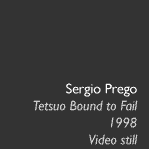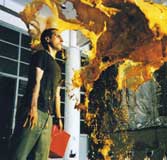


Royalty doesn’t travel the way it used to. In 1492, King Ferdinand and Queen Isabela of Spain commissioned Christopher Columbus to travel for them. Not a bad idea, considering that the adventurer’s fourth and final voyage not only ended in shipwreck and mutiny, but initiated Spain’s rocky relationship with America’s natives. Despite the limited success of ‘The Royal Trip’, as it was known, the journey inspired ‘The Real Royal Trip,’ a show by powerhouse curator Harald Szeeman. Promising a different kind of voyage - one of cultural exchange not conflict - the exhibition showcased work by several artists from Spain and a handful from South and Central America. Originated and part-funded by the Spanish Ministry of Foreign Affairs, it also aimed to demonstrate, in the words of MOMA director Glenn Lowry, “…the emergence of Spain as a major center for contemporary art.”
Despite the promising premise, few of the artists actually engaged directly with Latin American history or culture. One exception was Fernando Sánchez Castillo, whose installation of eight bronze dogs, hanging by their necks from lampposts in PS1’s courtyard mimicked an act by Peru’s Shining Path terrorists. Nearby, Pilar Albarracín personalized foreignness in her own country by piling a blue Mercedes with the possessions of an imagined family of North African immigrants.
The pervading influence here is not Latin America, but international pop culture. Carles Congost’s overacted soap-opera video starred a teen vampire who worries her parents. Ana Laura Aláez also tapped the world of youthful glamour in ‘Superficiality,’ a music video featuring models in adventurous makeup dancing to electro-pop. By contrast, documentary work that was specific to a given place and time was the strongest element here. Cristina García Rodero’s large, black and white photographs of rituals in Spain and Haiti was an exhibition unto itself. Wide-eyed Haitians in the grip of spiritual ecstasy appeared alongside theatrical Spanish renditions of feast day rituals, comparing ‘exotic’ rites with equally bizarre images from home. In an unusual curatorial twist, two documentary videos focused on the life work of Justo Gallego, a 78 year old man who has been hand-building a cathedral since 1963.
‘The Real Royal Trip’ included painting, sculpture, video and even a web project by Antoni Abad, but despite touching all the bases, didn’t live up to its proposal to map the intersection of Spanish and Latin American art. In order to really explore this territory, more Latin American artists should have been invited to participate; then, PS1 Director Alana Heiss would not have had to write in her catalogue essay that, “…the inclusion of Ernesto Neto ensures that the great South American dream is also represented,” as if a single artist could represent an entire continent.
It’s hard not to imagine that Szeeman, credited with helping to bring contemporary Chinese art to the attention of the Western world in the 48th Venice Biennale, was tapped to create a similar miracle for Spanish art. Instead, the near complete lack of wall texts and catalogue essays which sometimes fail to even mention the artists do a poor job of introducing their work to a New York audience. Like Columbus leaving the new world for the last time, visitors to ‘The Real Royal Trip’ will leave only slightly more enlightened than when they arrived.